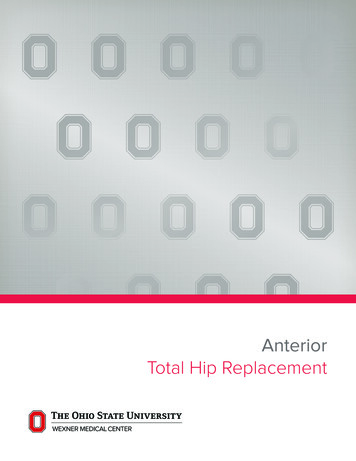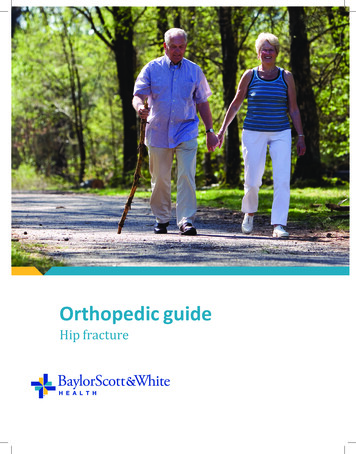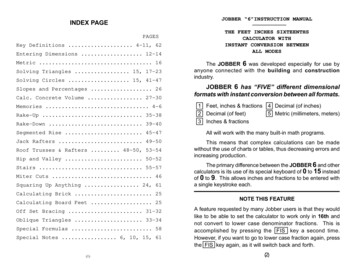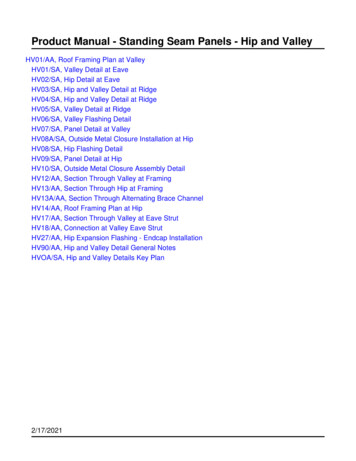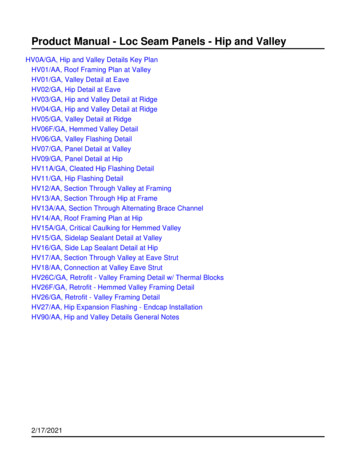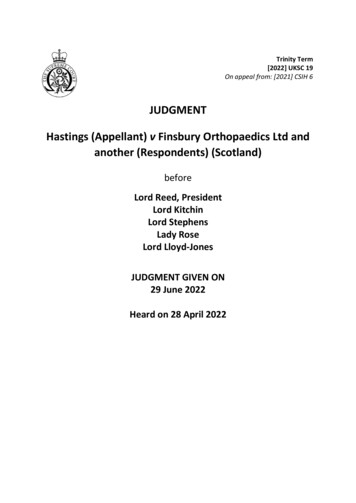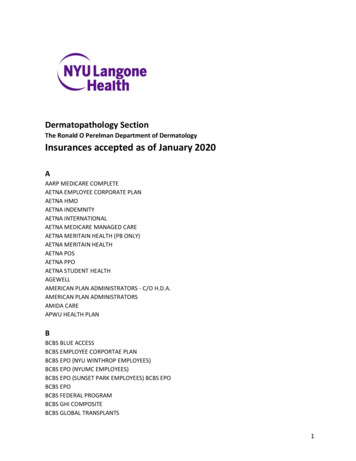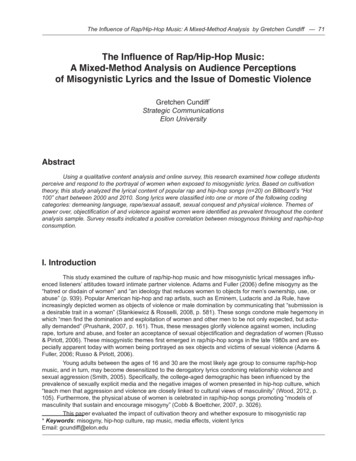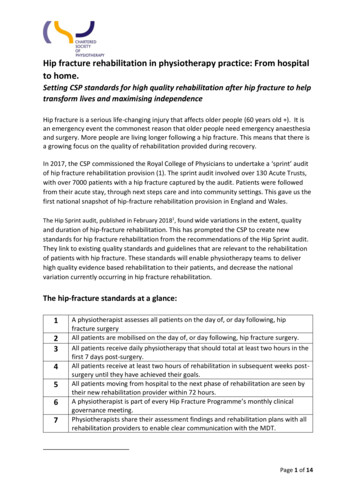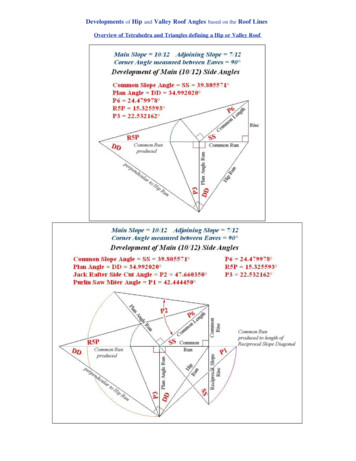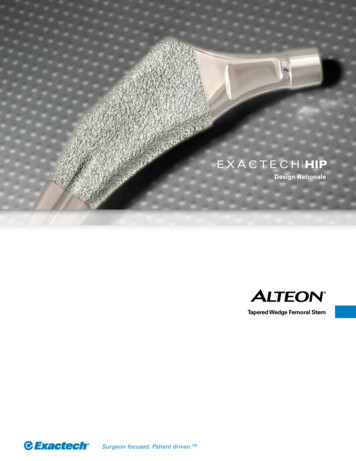
Transcription
E X A C T E C H HIPDesign RationaleTapered Wedge Femoral StemSurgeon focused. Patient driven.TM
Table of ContentsIntroduction. 1Design History and Evolution of Wedge Stems. 3Summary of Success. 3Unmet Clinical Needs. 4DISTAL POTTING OF THE FEMORAL STEM. 4DELAYED IMPLANT OSSEOINTEGRATION& SUBSIDENCE . 4PERIPROSTHETIC FRACTURES. 5THIGH PAIN. 5Exactech Implant Design Philosophyfor Tapered Wedge. 6DESIGN GOALS. 6PROXIMAL/DISTAL GEOMETRY. 6INCREMENTAL SIZING. 7PLATFORM INSTRUMENTATION . 9Conclusion. 9References. 10
The word “Alteon” is derived from the Latin word “altus” meaning “high,”denoting Exactech’s high performance, next-generation hip system. Thissystem is designed to deliver a reproducible, efficient and predictableclinical experience.IntroductionThe Alteon Tapered Wedge is a next-generation, single-taper, wedge-style stem. It incorporates specific philosophies,and is designed to improve surgical experiences and clinical outcomes.The Tapered Wedge collarless design intends to achieve immediate axial and rotational mechanical stability betweenthe medial and lateral cortices of the femoral canal. This is achieved through a proprietary combination of: Optimized proximal/distal geometrySix degree single medial/lateral (M/L) taperInterconnected macro-pore titanium plasma coatingIncremental sizing Lateral flare geometry Distal corner radii Varus relief1
FIRST GENERATION1981DePuy Tri-LockSECOND GENERATION20081982Biomet TaperLocBiometTaperLocComplete(RDD)NEXT GENERATION2014EXACTECH ALTEONTAPERED WEDGE2001StrykerAccolade2009DePuyTri-Lock BPS20122003StrykerAccolade IIZimmerM/L Taper2
Design History and Evolution of Wedge StemsPrevious iterations of single-taper, wedge-style stems canchanges to the stem and head prostheses emerged,generally be classified into first- and second-generationthe transition from first- to second-generation stemsdesigns. Traditional, first-generation, single-taper wedgeoccurred. This eventually led to design modificationsstems are based off the cemented Mueller stem of thethat included, but are not limited to: cut off or shorter1970s. These stems initially featured proximally coated,overall prosthesis length, reduced distal geometry stems,cobalt chrome implants that quickly evolved to titaniumand modular necks to account for varying anatomicalalloy. These first-generation implants were typically longermorphologies. Most of these designs also featured ain overall size and featured a more robust distal shape.constant medial curvature throughout the entire sizeSingle-taper, wedge-style stems showed continuedevolution over the last thirty years. As the industryrange and grew laterally with size, the exception being theAccolade II design.continued to advance in the area of materials, andSummary of SuccessHealy et al. noted that a “flat, tapered wedge femoralstem design provides excellent femoral reconstruction fortotal hip arthroplasty (THA).”1 The table below highlightsthe implant survivorship of both first- and secondgeneration, single-taper wedge stem designs.1-9YearStem DesignType NameBurt et al.1998Tri-Lock CoCrFirst Generation4498.0% @ 10 yearsParvizi et al.2004TaperlocFirst Generation11199.1% @ 10 yearsLettich et al.2007Accolade IFirst Generation54799.4% @ 4.35 yearsMcLaughlin et al.2008TaperlocFirst Generation14599.0% @ 22 yearsHealy et al.2009Tri-Lock CoCrTri-Lock TitaniumFirst Generation35899.5% @ 4.7 yearsWhite et al.2012Accolade IFirst Generation36797.0% @ 5 yearsMcLaughlin et al.2010Taperloc RDDSecondGeneration12399.0% @ 16 yearsMcLaughlin et al.2011TaperlocFirst Generation7697.0% @ 18 yearsCosta et al.2012Accolade IFirst Generation3596.0% @ 4.5 years3# of HipsAseptic Survivorshipof StemAuthor
Unmet Clinical NeedsDISTAL POTTING OF THE FEMORAL STEMIn spite of historical implant success, several clinical challenges remainedunaddressed with the second-generation implant designs. One ofthese challenges is proper medial/lateral fixation of the tapered wedgeimplant in femurs that have a substantially greater proximal/distal canalmismatch. Cooper et al. noted that risk factors associated with failure ofosseointegration (of the implant) included a smaller canal-flare index, and agreater canal fill at the mid-and distal-thirds of the stem.10 This complication,where an implant fills the femoral canal distally before M/L fixation isachieved proximally, is most often seen in Dorr Type A Femora and iscommonly referred to as “distal potting” of the implant.Distal Potting of a Zimmer M/L TaperStem in Type A FemoraDELAYED IMPLANT OSSEOINTEGRATION & SUBSIDENCEAnother clinical issue presented with first-generation versus currentsingle-taper, wedge-style stems was migration of the femoral stem. Aretrospective analysis conducted by White et al. demonstrated a “highincidence of migration” of the Accolade I.6The average subsidence of the Accolade I device at 24 months was1.3mm with five-year survivorship for aseptic loosening to be 97 percentwith revision as an endpoint and 95 percent for radiographic failure.6 ThisDelayed Implant Subsidencestudy noted that factors predictive of migration included larger stem size,lower canal flare index (i.e. Dorr A Femora), and the implant having a lowermodulus of elasticity (making it more flexible) compared to traditionaltitanium alloys.Jacobs and Christensen reported that “many factors influence implantmigration in the first postoperative year including, sex, age, weight andactivity level; and design characteristics of the femoral stem.” Their studyalso showed “significant progressive subsidence” between the six-weekand annual follow-ups of patients who had first-generation, cementlesswedge stems implanted.114
PERIPROSTHETIC FRACTURESStudies have reported that periprosthetic fractures following primarytotal hip arthroplasty performed using a non-cemented tapered wedgestem design have increased since their first introduction. Cooper andRodriguez suggest the increased incidence of periprosthetic fracturesin first-generation, single-taper wedge stem designs (Accolade I) maybe due to “the hand broached preparation technique necessary toachieve a tight press-fit for immediate component stability, or due tothe wedge-shaped design of this (particular) implant.” The incidence ofthese fractures is relatively low (a range of 0.4 percent to 0.6 percent)but it is suggested that different implant taper geometries may allowone to avoid this problem.10THIGH PAINHealy conducted a prospective randomized study to evaluate theincidence of thigh pain in patients who received a non-cemented, firstgeneration wedge-style stem. The study showed 20/390 or 5.1 percentof the patient cohort presenting with thigh pain. The study also showedthat the incidence of thigh pain was greater in patients who receivedthe cobalt chromium implant versus those that received the titaniumimplant.1 It has also been noted that second-generation wedge stemsalso present with thigh pain, consistent with the first-generation pressfit designs.5Periprosthetic Fracture withTaperloc Microplasty Stem
Exactech Implant Design Philosophyfor Tapered WedgeSince its founding in 1985, Exactech has operated with a primary goal of providing implants and services thatseek to improve patient outcomes. The Tapered Wedge Surgeon Design team, Jeff Pierson, MD, (FranciscanSt. Francis Health, Carmel, Indiana) and Micahel Kang, MD, (Insall Scott Kelly Institute, New York , New York),alongside our engineering team, set out with several design goals in mind to address the clinical challengespreviously mentioned.DESIGN GOALS1)The proximal/distal stem ratio should allow the implantThe stem should never exceed 1.25mm in growthto achieve fixation in all primary femur types (Dorr A,B,C)throughout the distal body in order to avoid jumps in sizewithout compromising implant features or surgicalthat may be too large.technique. Specifically, there is a need to be able to4)address Dorr A Femora where distal reaming may beThe femoral stem shall achieve immediate axial androtational stability.required for competitive designs.2)3)5)The stem should incorporate features that allowThe stem should be able to solve common kinematiccompatibility with all surgical approaches, but notissues without the need for modular neck components.compromise the ability of the geometric features toprovide mechanical fixation (i.e. length of the stem is nottoo short to provide the potential for three-point fixation).PROXIMAL/DISTAL GEOMETRYThe combination six degree single M/L taper and three degree anterior/posterior (A/P) taper of the femoral stem provides an intentional wedgefit within the metaphysis of the proximal femoral canal that is in strongcontrast to occasional diaphyseal fixation seen with first- and some secondgeneration wedge stems. It has been reported that distal fixation of firstgeneration single-taper wedge stems leads to higher than expected failurerates for osseointegration, migration and loosening.6, 11In order to achieve the first design goal, Alteon Tapered Wedge features anoptimized overall length and proximal/distal sizing to achieve fixation in allprimary femur types (Dorr A, B, C) without compromising implant featuresor surgical technique.12 In addition, the Tapered Wedge maintains all levels offixation available without compromising one by shortening the overall lengthof the stem. The design still incorporates a reduced distal geometric shape,Alteon Tapered Wedge Femoral Stemas compared to other single-taper wedge stems available in the market.126
Standard Base Neck LengthINCREMENTAL SIZING42In order to satisfy design goal number two,40solving common kinematic issues without the38was taken when designing the neck grouping36scheme for the Tapered Wedge stem. Somefirst- and second-generation competitivedesigns feature base neck lengths that aretoo large, have too large of a jump between(mm)need for modular necks, careful consideration343230stem sizes, or require modularity in order to28solve kinematic issues during the surgical261procedure.12234567891011121314151617The Tapered Wedge stem has four base neckAlteon Tapered Wedgelength groups. The system was intentionallyFirst-Generation Wedge (too long)designed so that a change between the neckSecond-Generation Wedge (large jump between sizes)length groupings could be accommodatedby changing the modular femoral headoffset, without affecting the overall totalleg length. Additionally, the stem has twooffsets, standard and extended, that sharea 131-degree neck angle, enabling offsetadjustments without affecting leg length.Implant GrowthIn order to satisfy the third design goal, theAlteon Tapered Wedge intentionally grows ata smaller rate lateral and distal (in the smallerstem sizes) when compared to the previousgeneration wedge stems. Consequentially,the Tapered Wedge system offers more sizes,versus some second-generation stems, toaccommodate a comparable size femur.Alteon Tapered Wedge SystemNeck Length Grouping and M/L GrowthGroup 1 Sizes 1, 2, 3, 4Group 2 Sizes 5, 6, 7Group 3 Sizes, 8, 9, 10Group 4 Sizes 11, 12, 13, 14, 15, 16*, 17**Items are special order.7
In order to achieve immediate axial and rotational stability of the implant,several geometric features were designed into the implant.The proximal/distaltransitional geometryresulted in a lateral flarefeature which is designed toevenly distribute loads in theproximal femur and provideinitial mechanical stability(see image below).14Low profile lateralshoulder allows forease of insertion whenimplanting the stem.2The Alteon Tapered Wedge features a highlypolished neck cross-section that is minimizedon the medial aspect to increase range ofmotion, decreasing the chance of postoperative dislocation, while material on thelateral side is maintained for strength.1313Distal corner radii aredesigned to achieveincreased torsionalstability through fourcorner contact.54Proximal body features an interconnected macropore Titanium Plasma Spray (TPS) coating thatprovides 1mm of overall implant to bone pressfit in the A/P plane and is line-to-line fit in the M/Lplane. Based on more than 25 years of clinical use,this coating (alongside the implant shape), helpsto provide initial mechanical stability and promotebiologic fixation.15,16“The lateral flare design is based on the theory that thelateral aspect of the femur is loaded in compression duringthe single-stance phase of gait. In addition to the loadtransfer from the femoral head to the medial femoral cortex,particular attention has been placed on the compressiveforces experienced at the base of the greater trochanter.It has been proposed that to reproduce the endostealcompressive forces between the femoral head and theproximal lateral femur, a femoral stem needs to engage thisregion by means of a lateral expansion or flare.”148
PLATFORM INSTRUMENTATIONThe Tapered Wedge is part of the Alteon family of hip stems. This platform hip system features a set of commonfemoral instruments that can be used across multiple stems.Alteon Common FemoralInstruments (Upper Level Tray)Alteon Common Femoral Instruments(Lower Level Tray)Alteon Tapered Wedge Instruments –Anterior Approach or all other approachesBROACH DESIGN The system uses rasping-style broaches. When the Tapered Wedge prostheses is impacted to anaxial stopping point, the proximal border of the TPS will beapproximately 1.5mm above the final broach. The Tapered Wedge brooches are designed to have a press-fitmedial to lateral of 0mm only at the midplane (i.e. coronal orfrontal) of stem; gradually increasing to 1mm total anterior toTapered WedgeDiamond Tooth Broachposterior. This Broach is designed to eliminate the potential ofthe distal TPS coating boundary prematurely achieving press-fitand eliminates the possibility of the broach introducing a stressriser as it cuts the femur.ConclusionThe Alteon Tapered Wedge Femoral Stem is a next-generation, single-taper wedge-style stem. By satisfyingthe surgeon focused design goals, this hip system offers a femoral component which incorporates subtle, yetsignificant design advancements over first- and second-generation wedge-style stems. The result is a robustsystem that offers a seamless surgical experience in the operating room.9
GLOBAL HEADQUARTERS2320 NW 66TH COURTGAINESVILLE, FL 32653 USA 1 352.377.1140 1 800.EXACTECH 1 352.378.2617Xwww.exac.com References1. Healy W, Tilzey J, Lorio R, Specht L, Sharma S.Prospective, Randomized Comparison of CobaltChrome and Titanium Trilock Femoral Stems. JArthroplasty. 2009;24:831-6.6. White C, Carsen S, Rasuli K, Feibel R, Kim P,Beaulé P. High Incidence of Migration with PoorInitial Fixation of the Accolade Stem. Clin OrthopRelat Res. 2012 Feb;470(2):410-7.11. Jacobs C, Christensen C. Progressive subsidenceof a tapered, proximally coated femoral stemin total hip arthroplasty. Int Orthop. 2009Aug;33(4):917-22.2. Burt C, Garvin K, Otterberg E, Jardon O. A FemoralComponent Inserted without Cement in TotalHip Arthroplasty. J Bone Joint Surg Am. 1998Jul;80(7):952-60.7. McLaughlin J, Lee K. Cementless totalhip replacement using second-generationcomponents: a 12- to 16-year follow-up. J BoneJoint Surg Br. 2010 Dec;92(12):1636-41.12. Data on File at Exactech. TR-2013-039. WedgeFemoral Stem Template Study Report.3. Parvizi J, Keisu K, Hozack W, Sharkey P,Rothman R. Primary total hip arthroplasty withan uncemented femoral component: a long-termstudy of the Taperloc stem. J Arthroplasty. 2004Feb;19(2):151-6.8. McLaughlin J, Lee K. Total hip arthroplasty withan uncemented tapered femoral component inpatients younger than 50 years. J Arthroplasty.2011 Jan;26(1):9-15.4. Lettich T, Tierney M, Parvizi J, Sharkey P,Rothman R. Primary total hip arthroplasty with anuncemented femoral component: two- to sevenyear results. J Arthroplasty. 2007 Oct;22(7 Suppl3):43-6.5. McLaughlin J, Lee K. Total hip arthroplasty withan uncemented tapered femoral component. JBone Joint Surg Am. 2008 Jun;90(6):1290-6.9. Costa C, Johnson A, Mont M. Use of cementless,tapered femoral stems in patients who havea mean age of 20 years. J Arthroplasty. 2012Apr;27(4):497-502.10. Cooper H, Jacob, A, Rodriguez J. Distal Fixationof Proximally Coated Tapered Stems MayPredispose to a Failure of Osteointegration. JArthroplasty. 2011;26:78-83.13. Data on file at Exactech. 711-01-80 The Effect ofFemoral Head and Cross Neck Section on Rangeof Motion Technical Profile.14. Leali A, Fetto J, Insler H, Elfenbein D. The effectof a lateral flare feature on implant stability. Int.Orthop. 2002;26(3):166-9.15. Data on file at Exactech. TR-2010-021. ImplantFixation in an Ovine Model (EBM, DMLS, Plasma)– Executive Summary.16. Data on file at Exactech. 711-12-80 TitaniumPlasma Spray Technical Profile.*Laboratory and/or animal study tests are not necessarily predictive of clinical outcomes.Exactech, Inc. is proud to have offices and distributors around the globe.For more information about Exactech products available in your country, please visit www.exac.comFor additional device information, refer to the Exactech Hip System–Instructions for Use for a device description, indications, contraindications,precautions and warnings. For further product information, please contact Customer Service, Exactech, Inc., 2320 NW 66th Court, Gainesville, Florida32653-1630, USA. (352) 377-1140, (800) 392-2832 or FAX (352) 378-2617.Exactech, as the manufacturer of this device, does not practice medicine, and is not responsible for recommending the appropriate surgical techniquefor use on a particular patient. These guidelines are intended to be solely informational and each surgeon must evaluate the appropriateness of theseguidelines based on his or her personal medical training and experience. Prior to use of this system, the surgeon should refer to the product packageinsert for comprehensive warnings, precautions, indications for use, contraindications and adverse effects.The products discussed herein may be available under different trademarks in different countries. All copyrights, and pending and registered trademarks,are property of Exactech, Inc. This material is intended for the sole use and benefit of the Exactech sales force and physicians. It should not beredistributed, duplicated or disclosed without the express written consent of Exactech, Inc. 2015 Exactech, Inc. 711-71-40 Rev. A 0815
White et al. 2012 Accolade I First Generation 367 97.0% @ 5 years McLaughlin et al. 2010 Taperloc RDD Second Generation 123 99.0% @ 16 years McLaughlin et al. 2011 Taperloc First Generation 76 97.0% @ 18 years Costa et al. 2012 Accolade I First Generation 35 96.0% @ 4.5 years Year Stem Design Type Name 1998 Tri-Lock CoCr First Generation
